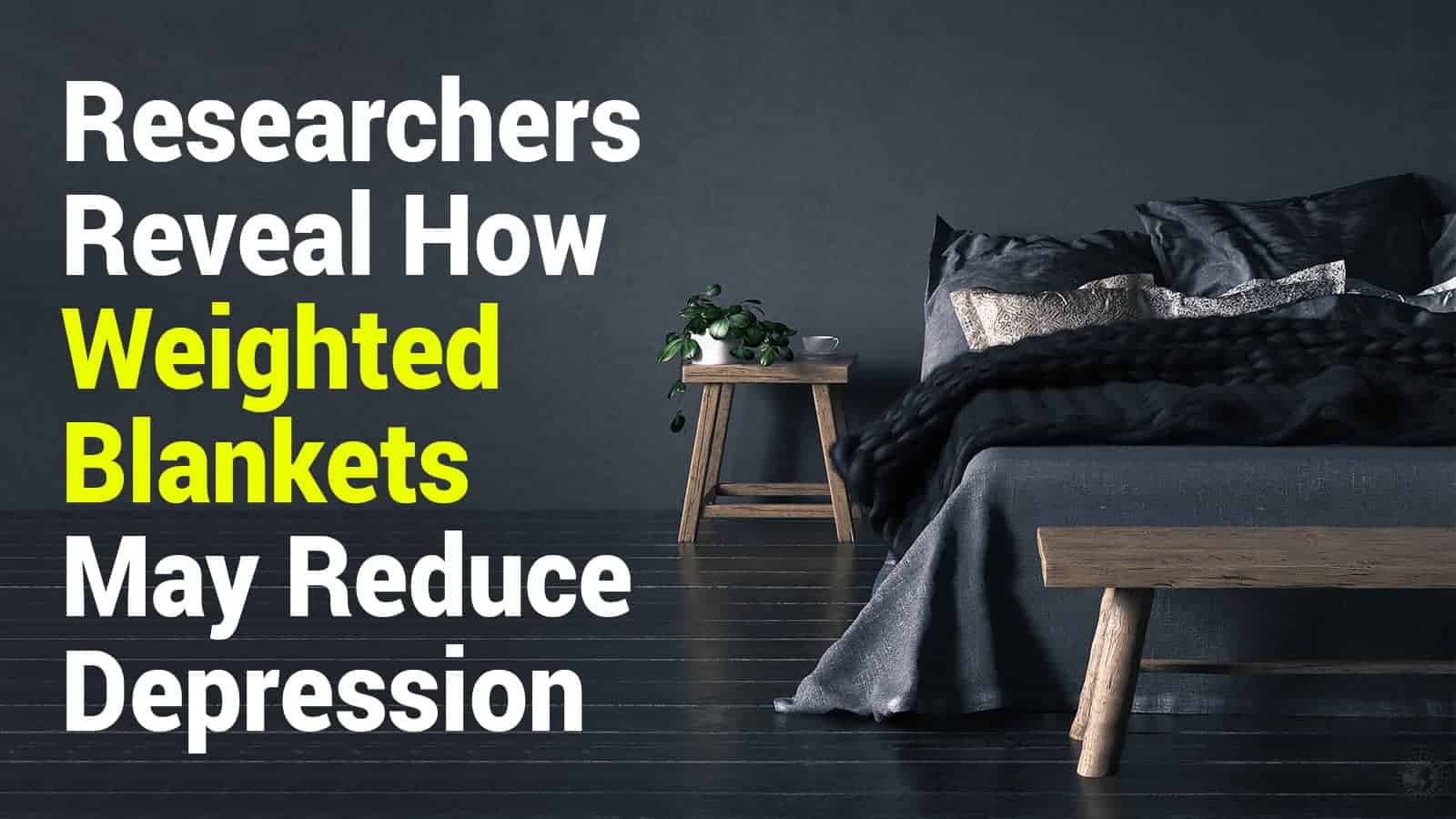Many who struggle with depression have turned to a weighted blanket to ease their depressive symptoms.
One of the ways we have to comfort ourselves is to fold our arms across our bodies. It’s a way of simulating a hug. Sadly, it falls short in being as truly comforting as someone giving us a warm, full-body, close hug. You know the kind I mean: fully embraced in their arms, bodies feeding warmth to each other and not an inch to see through. Those hugs that make you want to rest your head on their shoulder or chest and let all the stress flow away. Those hugs that make you feel safe and loved.
Apparently, I’m not the only one in a shortage of those hugs because a few years ago, a company designed weighted blankets for the general public. Weighted blankets are a cozy alternative to feeling that warm and fuzzy embrace. They help many people with mental or emotional challenges, including depression and anxiety. What does a weighted blanket bring to someone with depression? Researchers reveal how weighted blankets can help with depression.
The Science Behind a Healing Touch
Let’s go back to that hug. Just close your eyes for a moment and imagine it again. Aaahhh. Don’t forget to include that gentle rub on the back with the hug. Even memory can help you relax for a moment. It is no wonder that specific therapies involving touch benefit people physically and emotionally.
A revealing study
One study, run by Clare Weze, analyzed cases at the Centre for Complementary Care in Cumbria, CA. Patients of the center typically lacked the funds to receive care. It created improvements in those who had psychological and physical ailments through the use of gentle touch. A soft touch was described as a touch that was firm but as gentle as one would use to smooth over a child’s brow or to check their forehead for a fever.
Caregivers applied the touch with fingertips or the palm. They did not knead or massage, they just laid hands on the participants. The therapists would touch the patient’s head, legs, arms, chest, and feet, over their clothing. Time spent on each area would vary, in part based on the area needing healing, but the session would last for about 40 minutes.
Clare Weze reviewed cases of 147 volunteers who attended the Centre from 1995 to 2001 who had reported various psychological difficulties, with or without an illness contributing. Most of the psychological conditions related to mental stress, anxiety, depression, and grief. The patients had been experiencing the conditions for 1-5 years. Some had been or were on medication, had previously done psychotherapy or massage therapy.
The markers to check for improvement included; stress, pain, anger, fear, panic, sleep, relaxation, ability to cope, and overall health score. Each of these markers, except overall health, was given a rating by the participants between 0-10. The scores were all at four or above before touch therapy. The average of all the scores measured overall health.
The study findings
They scored those same markers after treatment. The results were calculated after four sessions within 4-6 weeks, which was the minimal amount of time given to a client to test if this therapy would prove beneficial. In all areas, marked improvement was shown, except for sleep. Improvement in sleep while only going up by a few points, however, demonstrated it remained consistent. The feelings of fear, panic, stress, and anger went down to half of their first scores, and the rated ability to relax and cope virtually doubled in scores.
These results had proven consistent with two other studies Clare Weze had referenced in her report. One of the studies included 110 patients of various conditions, and the second consisted of 300 clients, also with a variety of ailments. In both studies, there was an improvement in physical and psychiatric wellbeing.
Deep Pressure Stimulation
Deep pressure stimulation is another form of touch. This is the touch we commonly associate with massages, gentle squeezes, hugs, and wrapping up in something of some weight, like a weighted blanket or vest.
According to Applied Behavior Analysis EDU, deep pressure stimulation motivates your body to go from high alert to calm and relaxed. It is the role of your sympathetic nervous system to keep you alert, aware, and vigilant throughout your day. Remaining in that state too long creates stress and anxiety, which results in fatigue, impatience, and digestive issues.
The relaxed state is the role of your parasympathetic nervous system. It takes you down from all of the high alert and stress to a state of relaxation. It produces endorphins to give you that warm and fuzzy feeling, slows your heart rate, causes your muscles to relax, and the blood in your body to flow at a more easy rate.
Various methods are used in therapy for individuals with an autism spectrum disorder, ADHD, high anxiety, pain, or other sensory overload conditions. Interestingly enough, children with autism have shown to be more sensitive to light touch and therefore respond better to a more deep pressure massage, as shown in this study.
How Else Might A Weighted Blanket Help?
Other studies demonstrate how deep stimulation can help improve in other areas:
1 – Coping skills related to painful procedures.
A study looked at various patients undergoing wisdom tooth removal surgeries. Those who received deep stimulated pressure were able to maintain a more neutral heart rate in the face of the stress as opposed to those who did not.
2 – Reduced anxiety related to mortality.
Study regarding how individuals with low self-esteem concurrently have a fear of their mortality and tend to seek more social engagement to feel better. Providing such individuals with hugs gave them a better ability to cope with the idea of death than they had previously.
3 – Reduced stress-related illness.
A study presented 406 individuals with a cold virus and then various forms of social interactions. Those who received hugs had a decline in physical symptoms.
4 – Make a bad day better.
A study analyzed the effect of hugs on individuals who got into a conflict that day. It demonstrated a decrease in negative feelings in those who hugged.
What is a weighted blanket?
What is better than waking up on a cold morning as snug as a bug in a rug? It turns out that a comforter or blanket is a mild version of what a weighted blanket is. Weighted blankets are not new; they are just new to the general public. Currently, they are the latest fad.
Weighted blankets have been in therapeutic use for several years as they have proven to be effective in calming individuals who are autistic or have sensory overload issues. They are a tool used to create deep pressure stimulation therapy. By calming their systems down, the individuals are better able to cope with various stimuli more effectively, sleep better, and demonstrate an improved mood.
These blankets simulate deep pressure stimulation therapy while you wrap up in them. This induces a relaxed sensation and may reduce stress on highly anxious people and aid in sensitivity to light touch.
In 2015, according to Psychology Today, a study used weighted blankets to test how they affected individuals. 33% reported a reduction in stress, 63% reported a decrease in anxiety, and 78% reported preferring it initiate a sense of calm.
Scientists believe that since it is simulating deep pressure stimulation therapy, it aids the body to release hormones related to mood and stress. This would include endorphins, oxytocin, and serotonin levels and a decrease in cortisol. All of these hormones link to depression, anxiety, and sleep.
 Choosing a Weighted Blanket
Choosing a Weighted Blanket
Weighted blankets are sewn with various pockets filled with tiny beads made of a variety of materials. By sewing the beads into pockets, it allows the weight to distribute evenly across the blanket. Manufacturers offer a range of fabrics from soft to smooth.
Some companies allow you to choose the fabric for the front and back of the blanket. Individuals select the weight of the blanket by the size and weight of the individual. Specific individuals should not use them, and children under the age of 5 should not use one. The blankets range in weight from 5 pounds to 25 pounds.
 Final Thoughts on Using a Weighted Blanket to Ease Depression
Final Thoughts on Using a Weighted Blanket to Ease Depression
We all value human touch in its various forms. Thus, science recently looked into how touch affects our systems and impacts our physical and emotional health. Researchers reveal how weighted blankets can help with depression through their imitation of deep pressure stimulation.
Therefore, weighted blankets for the general public can be a valuable tool. That’s because those who use them experience the following benefits:
- Better sleep
- Calming of the sympathetic nervous system
- The natural promotion of mood-enhancing hormones
So a weighted blanket cannot take the place of medication, therapy, and learning coping skills. However, it appears to make life a little easier to cope with and could be a definite addition to any treatment.

















